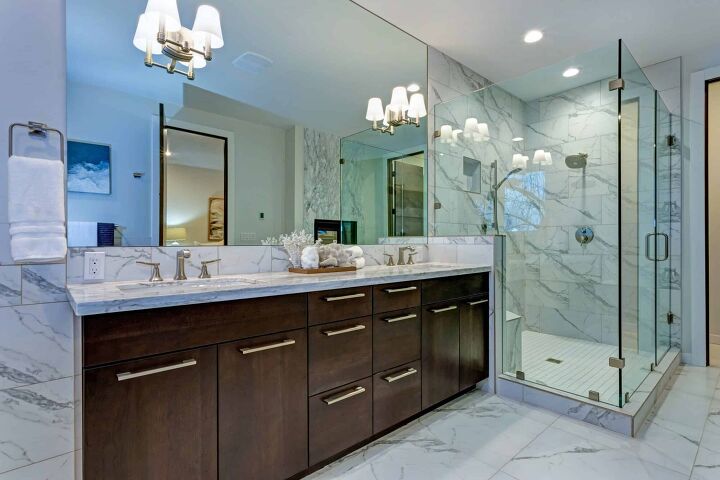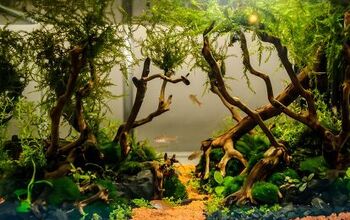How To Hang A Large Frameless Mirror (Step-by-Step Guide)

Frameless mirrors can be a classy addition to any room in a home. They will draw in more light and make your room feel larger and brighter. You might be used to hooks being attached to the back or top of a mirror when you are going to hang it on a wall, but don’t fret! Hanging a frameless mirror is an easy task as long as you have the right tools.
To hang a frameless mirror you will need to mark the spot you want to hang it and check for a stud. If there is a stud, screw the frameless mirror into that. If there is no stud, you will need to drill a hole that’s big enough to use a toggle bolt.
Related Guide: Are Mirrored Walls Out Of Style?
Do You Need Handyman Services?
Get free, zero-commitment quotes from pro contractors near you.

The Pros and Cons of a Frameless Mirror
Frameless mirrors are in style right now and you will find them at all the high-end furniture stores. They offer a seamless style that appeals to the modern aesthetic that is flooding the interior decorating market at the moment. Great for any room, they are especially good for moist and humid environments, as there are no frames to be affected by these issues.
A frameless mirror will make your room appear bigger and brighter, without being as noticeable as a mirror with a frame. It’s a great way to make use of a small space without it feeling cluttered and overburdened. This is why they make a great choice for small bathrooms, easily hanging over the sink without becoming a focal point.
The only real con to a frameless mirror is that its edges are more susceptible to damage than one with a frame. In order to mitigate any damage, take care when moving and installing the mirror. Rest it on a blanket or sofa before hanging instead of directly on the floor. You can also use small rubber cushions on the backside to keep it from pressing against the wall at an angle, to reduce pressure.
Hanging a Frameless Mirror
Hanging a frameless mirror involves a little more work than a framed one because the mounting hardware is usually attached to the frame. However, it is not terribly difficult, and you should have no issues installing one yourself. It is easier if you have another set of hands, but it can also be done solo.
Tools
In order to hang a frameless mirror, you will need the right tools. It is not much different than hanging a mirror with a frame, so don’t worry, there aren’t any special purchases you need to make.
- Stud finder
- Level
- Pencil
- Drill
- Hammer
- Screws
- Toggle Bolts (if not securing to a stud)
- Mounting Hardware
There are a few varieties of mounting hardware for you to choose from.
- Mirror Clips
- Wire or Z Clips
- Mirror Adhesive
Mirror Clips hold your frameless mirror in place. You will lightly secure them to the wall and then slide the mirror into place, then secure them all the way.
Wire or Z clips are part of a mounting system. One of the parts will be attached to the back of the mirror, the other side to the wall. You will then slide the mirror onto the wall piece, with the two parts nestled together. These will follow the same general principle as Mirror Clips when it comes to installation.
Mirror Adhesive is just that, an adhesive that will stick your mirror to the wall. These are used for smaller mirrors that do not have a lot of weight to them. These are great for their ease of application and can have you hanging a mirror in minutes.
The drawback is that because the adhesive is so strong, they may pull some of your paint off the wall when removed later. They are also harder to adjust if you did not measure correctly. If this happens, you will need to reapply the adhesive, usually in the form of a two-sided sticker.
Mounting Your Frameless Mirror
If you are using a heavy mirror, it is important that you secure it to a stud or use toggle bolts. A stud can hold a lot of weight, though they may not be in the exact place you wish to hang your mirror. Toggle bolts will solve this problem, as they can be installed anywhere that a stud isn’t. Different toggle bolts are rated to hold different weights, so make sure the ones you purchase are rated for the right load.
Step 1: Finding The Stud
Run your stud finder along the wall and locate where the studs are, in relation to where you want to hang your mirror. If you have wiggle room it is best to hang on a stud. Mark where one of the stud ends begins and ends and find the center. This is where you will want to secure your mount.
If you are using toggle bolts, select the height at which you would like to hang your mirror. When located, place a small X where the hole you need to drill will be. If you need to install several anchor points, use a level to make sure everything is even and in line with each other.
Step 2: Installing the Hardware
Using a drill bit that is slightly smaller than the anchor, make a hole where your X is. Go slow and steady so that you make a clean hole. Make sure that when you are pushing in the anchor, it is a snug fit.
You will then push your anchor into the hole and then tap it the rest of the way in with the hammer. Once fully inside the wall, pull on the screw piece so that the toggle will open inside the wall.
For Mirror Clips and Z Clips:If you are using a mounting system, such as Z Clips, you will install the wall side to the wall using toggle bolts. After drilling a hole in the wall and before sliding in the toggle bolt, you will remove the bolt from the toggle and slide it through the holes of the Z Clips. Then reattach the bolt to the toggle and slide it into the wall, following the same procedure. As you tighten the bolt it will cause the toggle in the wall to come closer, securing everything in place.
Step 3: Hanging the Mirror
With your wall ready for the mirror, you will either line up the slots in the back of the mirror with the toggle bolts and slide them in. If you are using a mounting system, you will rest the part that is attached to your mirror, to the part hanging on the wall.
The final touches are if you decide you want the mirror to be flush with the wall, and not slightly angled. If so, you can attach small rubber pads behind the mirror to elevate it off the wall, these have an adhesive on one side to stick to the mirror.
Do You Need Handyman Services?
Get free, zero-commitment quotes from pro contractors near you.

Related Questions
How Much Weight Can A Drywall Anchor Hold?
Drywall anchors are rated for different weights, depending on the type, but not good for hanging mirrors. For hanging a frameless mirror, it is best to use toggle bolts, which offer more security. These can hold from 30 to 50 pounds, with some rated for more. Do not use drywall anchors for securing anything other than light artwork. These can pull out of the drywall and cause your mirror to crash to the floor.
Do I Need to Use a Stud?
You should always hang anything over 10 pounds in a stud. This is the easiest and safest way to hang heavier items, as studs run from floor to ceiling and are very secure. If there isn’t a stud nearby, you can use toggle bolts or other heavy-duty anchors. For extra security, use more than one toggle bolt when hanging a heavy item.
How High Should Mirrors Be Hung?
The average height that an interior decorator will hang a mirror is 55” to 65”. This depends on if the mirror is going above an object, like a sofa or sink. This is why it is a good idea to have a second set of eyes when hanging mirrors. That way one of you can hold it and the other can step back and take a look. There is no strict guideline when it comes to mirror height, so use your best judgment.

Sean Jarvis is an interior decorator, writer, and expert handyman. Well versed in everything home improvement, he is a savant at manipulating words and spaces and upgrading everything around him. Sean specializes in writing concise guides about appliance repair and installation, home and lifestyle, and other residential projects.
More by Sean Jarvis



























